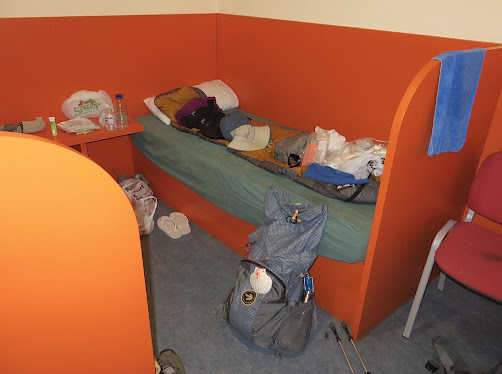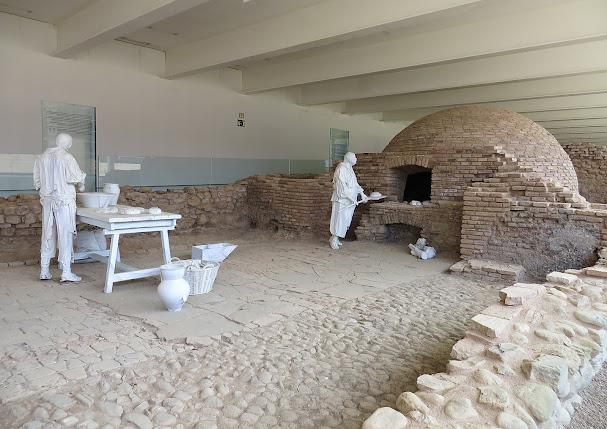Dad's socks are air drying on his pack. If laundry is still a little damp in the morning, it's tied on wherever possible. The shell and patch on the pack include the Cross of St. James, which is associated with the Order of St. James, a medieval military order that protected pilgrims.
Buildings in the town of Castiello de Jaca included conical shaped chimneys unique to the Aragon region.
The Romanesque church of San Miguel Arcangel in Castiello de Jaca has a white-washed stone interior. This church is renowned for having 100 relics kept in a silver chest that's opened by the mayor every first Sunday in July for all to see. A legend associated with the relics involves a pilgrim helped by villagers who repaid their generosity with a sack of relics meant to be brought to Santiago. As the story goes, among the objects was a thorn from Christ's crown of thorns.
The ruins of Ermita de San Cristobal from 1796 lies among vegetation near Jaca.
Jaca is a bustling town of over 13,000 and known for tourism. Charming narrow streets crisscross cobbled lanes. Testimony to Jaca's status as a major medieval pilgrim portal can be seen in old documents that note at least four hospices.
A shell and walking stick adorn a balcony.
A Dalmatian gives Dad a high five.
Our municipal albergue, Albergue de Peregrinos, had cubicles instead of the usual bunks. We stayed here two nights to see more of Jaca's sights.
Yesterday we visited the Ciudadela, a fortress located in the middle of town that was completed in 1641 to offer protection against a French invasion. It's a star-shaped pentagon with bulwarks and a drawbridge. Reindeer wander in the grass-filled moat.
Also seen was the Romanesque Catedral de San Pedro, completed in 1139 with renovations done in later centuries after fire damage. It's architecture set the style for many churches established along the Road to Santiago. Although rather dark inside, the interior has lots of noteworthy architectural details and art historical treasures.
The western entrance's tall archway
Plaza adjacent to the cathedral's gated southern entrance
A Virgen processional figure rests on a stand in front of the San Miguel chapel with a retablo.
16th c. starred vaulting canopies the nave.
Tonight we asked at the Cathedral's Diocesan Museum about a place to leave ex-votos. The woman who was working behind the desk led us to the Santa Ana Chapel with a small donativo table below a crucifix. I left the hand & uterus/ovaries with notes inside explaining whom they're for and physical challenges faced.
Today we also toured the monastery of San Juan de la Pena, which is high up in the hills outside of Jaca and accessed by car or bus. The site consists of a "new" monastery complex completed in the early 18th c. after a fire destroyed the "old" 9th c. monastery, which is located about a 15 minute walk down the hill.
The new monastery, which was built in a meadow
A museum at the new monastery shows how the monks lived, including baking bread.
The old complex was built into the side of a cliff and is an art historical jewel. Its original Visigothic style predated the Romanesque period. The cloister from the 12th c. was the architectural standout.
Views of the cloister
Detail from inside the main building
The bus we rode up to see the monastery wasn't leaving to go back to Jaca until 8:00 p.m. so we 'hitched' a ride with an American couple, Carl and Jurate, whom we met at the old monastery. Although they currently live in Virginia, both Carl and Jurate had gone to grad school at University of Michigan and have a summer cottage near Three Oaks, Michigan. Three Oaks is a town near where Dad and Mom grew up and in the area where family is still located.
Ending our stay in Jaca with an apple tart
and cups of cafe and tea





























No comments:
Post a Comment